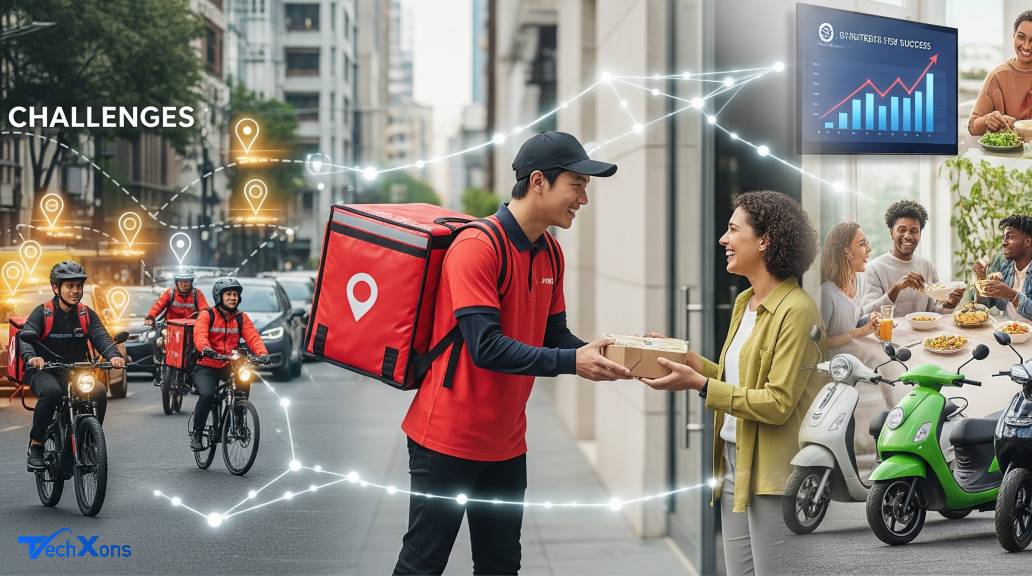
- By TechXons
- 13 Sep, 2025
- IT Consultancy
Unleashing the Potential of Food Delivery Apps: Challenges and Strategies for Launching a DoorDash-Like Platform
This article explores the booming $150 billion food delivery market as of 01:33 PM IST, September 13, 2025, with DoorDash leading as a top food delivery app, offering services like DoorDash free delivery and DoorDash flower delivery alongside partnerships with DoorDash restaurants. It outlines challenges of launching a food delivery service app, including logistics, restaurant onboarding, competition with popular delivery apps, scalability, payment security, regulatory compliance, driver retention, marketing, and monetization.
The food delivery industry has transformed how we dine, with apps like DoorDash leading the charge. As of September 13, 2025, the global food delivery market is valued at over $150 billion, driven by convenience and technology. DoorDash, a top food delivery app, connects millions of users with DoorDash restaurants, offering features like DoorDash free delivery promotions and even DoorDash flower delivery. For entrepreneurs, launching a DoorDash-like platform presents a golden opportunity to tap into this booming sector. However, building a successful food delivery service app comes with significant challenges, from logistics to competition with popular delivery apps. For companies like Techxons, which specialize in providing solution clones, a DoorDash clone offers a fast track to market entry with customizable features.
The Evolution of Food Delivery: DoorDash’s Rise to Prominence
Food delivery apps have revolutionized dining since the early 2010s. DoorDash, founded in 2013, emerged as a leader among popular delivery apps, expanding beyond meals to include DoorDash flower delivery and grocery options. By 2025, it serves over 30 million users monthly, partnering with thousands of DoorDash restaurants. Its success hinges on real-time tracking, user-friendly interfaces, and occasional DoorDash free delivery offers, setting a benchmark for top food delivery apps.
Other most popular delivery apps like Uber Eats, Grubhub, and Postmates compete fiercely, making the market crowded. A restaurant ordering app or ordering apps clone must differentiate itself to stand out. Techxons’ DoorDash clone solutions provide pre-built features like order management and driver coordination, enabling startups to launch quickly while competing with the top delivery apps.
Key Challenges of Launching a DoorDash-Like Platform
1. Logistics and Delivery Optimization
Efficient delivery is the backbone of any food delivery service app.
Why It’s a Challenge:
Coordinating drivers, managing traffic, and ensuring timely deliveries are complex. Popular food delivery apps like DoorDash use advanced algorithms, but new platforms struggle with route optimization and driver availability, especially during peak hours.
Solutions:
- AI Routing: Implement AI-driven route planning, a feature in Techxons’ DoorDash clone.
- Driver App Integration: Develop a DoorDash driver app for real-time updates and navigation.
- Partnerships: Collaborate with local couriers to scale operations.
Optimized logistics enhance customer satisfaction, a key factor for top food apps.
2. Onboarding Restaurants and Maintaining Quality
Partnering with DoorDash restaurants and ensuring food quality is critical.
Why It’s a Challenge:
Convincing restaurants to join a new platform is tough against established players. Inconsistent food quality or late orders can damage reputation, a common issue with most popular food delivery app clones.
Solutions:
- Incentives: Offer lower commission rates initially, as Techxons’ clones allow flexible pricing.
- Quality Checks: Use feedback systems to monitor restaurant ordering app performance.
- Training: Provide guides for restaurants on order handling.
Quality partnerships boost credibility among top 10 food delivery apps.
3. Competing with Established Players
Standing out among popular delivery apps requires innovation.
Why It’s a Challenge:
DoorDash, Uber Eats, and other top food delivery apps have loyal user bases and strong branding. New ordering apps clones face an uphill battle to attract users.
Solutions:
- Unique Features: Add niche services like DoorDash flower delivery.
- Promotions: Launch with DoorDash free delivery offers to draw users.
- SEO Strategy: Target keywords like “most popular food delivery app” in content.
Differentiation is essential to compete with the most popular delivery apps.
4. Scalability and Technical Infrastructure
Handling high traffic and large orders is a must for growth.
Why It’s a Challenge:
Scalability issues can crash a food delivery service app during peak times, driving users to competitors. Managing data for top delivery apps requires robust servers.
Solutions:
- Cloud Hosting: Use AWS, as Techxons’ DoorDash clone is cloud-ready.
- Load Balancing: Distribute traffic to prevent downtime.
- Testing: Simulate high-volume scenarios to ensure performance.
Scalability ensures your platform ranks among the top food apps.
5. Payment Security and Transparency
Secure, transparent payments are vital for users and restaurants.
Why It’s a Challenge:
Integrating multiple payment methods and ensuring PCI compliance is complex. Disputes over charges can deter users from ordering apps.
Solutions:
- Secure Gateways: Integrate Stripe or PayPal, supported by Techxons’ clones.
- Clear Billing: Display costs upfront, including any DoorDash free delivery terms.
- Dispute Resolution: Offer quick mediation for payment issues.
Secure payments build trust, a hallmark of successful restaurant ordering apps.
6. Regulatory Compliance and Licensing
Food delivery apps face strict regulations.
Why It’s a Challenge:
Local health codes, delivery worker rights, and tax laws vary by region. Non-compliance can lead to fines or bans, a hurdle for DoorDash clone platforms.
Solutions:
- Legal Partnerships: Consult experts for compliance, a feature in Techxons’ solutions.
- Driver Licensing: Verify driver credentials via the DoorDash driver app.
- Transparent Policies: Clearly outline terms for users and restaurants.
Compliance ensures long-term viability among top delivery apps.
7. Driver Recruitment and Retention
A reliable driver pool is essential for a DoorDash-like platform.
Why It’s a Challenge:
Attracting and retaining drivers is competitive, especially with DoorDash driver app incentives. High turnover can disrupt services.
Solutions:
- Incentives: Offer bonuses or flexible schedules via Techxons’ clones.
- Support: Provide 24/7 assistance through the driver app.
- Feedback Loop: Use driver input to improve working conditions.
A strong driver network supports growth in the food delivery service app market.
8. Marketing and User Acquisition
Gaining visibility in a crowded market is challenging.
Why It’s a Challenge:
High marketing costs and competition from most popular delivery apps require innovative strategies.
Solutions:
- SEO Optimization: Target “ordering apps clone” and “top food delivery apps” in blogs.
- Social Media: Run ads targeting food lovers on Instagram.
- Referrals: Offer discounts for new user referrals.
Effective marketing drives traffic to your DoorDash clone.
9. Monetization Strategy
Profiting while keeping the platform attractive is a balancing act.
Why It’s a Challenge:
High commissions can deter restaurants, while low fees limit revenue, a concern for most popular food delivery app clones.
Solutions:
- Commission Model: Charge a percentage per order, adjustable in Techxons’ admin panel.
- Subscription Plans: Offer premium features for restaurants.
- Ads: Include targeted ads for DoorDash restaurants.
A solid monetization plan ensures sustainability.
Strategies for Success in the Food Delivery Space
1. Leverage Techxons’ DoorDash Clone
Techxons offers pre-built DoorDash clone solutions, cutting development costs ($50,000–$150,000) to weeks. Features include:
- Order Management: Real-time tracking for restaurant ordering apps.
- Driver Coordination: Integrated DoorDash driver app.
- Customizability: Tailor for niches like DoorDash flower delivery.
2. Focus on Local Markets
Target specific regions with localized restaurant partnerships to stand out among top 10 food delivery apps.
3. Enhance User Experience
Offer features like order customization and DoorDash free delivery to attract users.
4. Invest in SEO and Content
Create articles like “challenges of launching a DoorDash-like platform” to rank for “most popular food delivery app clone.”
5. Build Strong Restaurant Relationships
Provide tools and support to integrate seamlessly with DoorDash restaurants.
Case Studies: Lessons from the Field
- Uber Eats: Grew by leveraging its ride-sharing network, a model for ordering apps clones.
- Grubhub: Focused on college towns, inspiring niche strategies.
- Techxons Clients: Launched regional food delivery apps, hitting 15,000 orders monthly within a year.
Step-by-Step Guide to Launching Your DoorDash Clone
- Market Research: Identify local demand for top food apps.
- Choose Techxons’ Clone: Select a script with desired features.
- Integrate Systems: Add payment and driver tools.
- Partner with Restaurants: Onboard DoorDash restaurants.
- Test and Launch: Ensure mobile compatibility and performance.
- Market and Scale: Use SEO and promotions to grow.
Predictions for 2025 and Beyond
The food delivery market will grow with AI optimization, drone deliveries, and sustainability focus, positioning DoorDash clones for success.
Conclusion: Revolutionizing Food Delivery
Launching a DoorDash-like platform unlocks immense potential in the food delivery service app market. By addressing logistics, compliance, and competition challenges, startups can thrive. Techxons’ DoorDash clone solutions provide a headstart, embedding scalability and innovation. With strategic marketing and user-focused features, your platform can join the ranks of popular delivery apps.




